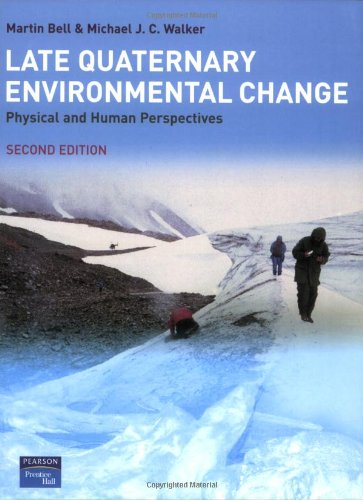

Most ebook files are in PDF format, so you can easily read them using various software such as Foxit Reader or directly on the Google Chrome browser.
Some ebook files are released by publishers in other formats such as .awz, .mobi, .epub, .fb2, etc. You may need to install specific software to read these formats on mobile/PC, such as Calibre.
Please read the tutorial at this link. https://ebooknice.com/page/post?id=faq
We offer FREE conversion to the popular formats you request; however, this may take some time. Therefore, right after payment, please email us, and we will try to provide the service as quickly as possible.
For some exceptional file formats or broken links (if any), please refrain from opening any disputes. Instead, email us first, and we will try to assist within a maximum of 6 hours.
EbookNice Team

Status:
Available0.0
0 reviews
ISBN 10: 0130333441
ISBN 13: 9780130333445
Author: Mike Walker, Martin Bell
Late Quaternary Environmental Change addresses the interaction between human agency and other environmental factors in the landscapes, particularly of the temperate zone. Taking an ecological approach, the authors cover the last 20,000 years during which the climate has shifted from arctic severity to the conditions of the present interglacial environment.
1 Environmental change and human activity
Introduction
Earth science, geography and archaeology
Changing perspectives in science
The causes of environmental change: cycles, pattern and chance
Questions of scale: space and time
Environmental change and human perception
Scope and structure of the book
Note on dates
2 Evidence for environmental change
Introduction
Scientific methodology
Inductivism
Falsification
Multiple working hypotheses
Chaos theory
Uniformitarianism
Fossil evidence
Macrofossils
Microfossils
Sedimentary evidence
Peat
Lake sediments
Cave sediments
Glacial sediments
Periglacial deposits
Slope deposits
Alluvial deposits
Aeolian deposits
Palaeosols
Coastal deposits and landforms
Marine sediments
Ice cores
Isotopic evidence
Microfossils in deep-ocean sediments
Ice cores
Speleothems
Tree rings
Peat
Lake sediments and other isotopic studies
Historical evidence
Weather records
Weather-dependent natural phenomena
Phenological records
Instrumental records
Assessment of proxy data sources
Uniformitarianism
Equifinality
Taphonomy
Preservation and contamination
Climatic inferences from historical data
Climatic inferences from other proxy data
Dating of proxy records
Radiometric dating
Incremental dating
Age equivalence
Artefact dating
Notes
3 Natural environmental change
Introduction
Patterns of long-term climatic change
Evidence for long-term climatic change
The nature of long-term climatic change
Climatic changes in the North Atlantic region during the last cold stage
Greenland
North Atlantic
Europe
The British Isles
Northern United States, Canada and the Arctic
Causes of long-term climatic change
The astronomical theory
Elements of the astronomical theory
Evidence in support of the astronomical theory
Modifications to the astronomical theory
Patterns of short-term climatic change
The Lateglacial climatic oscillation
The early Holocene amelioration
The Climatic Optimum (the Hypsithermal)
The late Holocene deterioration
The historical period
Cyclical climatic change during the Holocene
Causes of short-term climatic change
Solar output variations
Volcanic aerosols
Geomagnetism
Ocean circulation
Atmospheric trace gases
Notes
4 Consequences of climatic change
Introduction
The last glaciers in the northern temperate zone
Europe
The British Isles
North America
Iceland and Greenland
Deglaciation: the ocean record
The Lateglacial: Europe
The Lateglacial: North America
Holocene glacier activity
Periglacial activity
Europe
North America
Sea-level change
Components of sea-level change
Glacio-isostatic changes
Glacio-eustatic changes
Vegetational and pedological changes
Models of vegetational and pedological change
The ‘cryocratic' phase
The ‘protocratic' phase
The ‘mesocratic' phase
The ‘oligocratic phase'
Palaeohydrological changes
The fluvial record
Glaciofluvial deposits
Glacial lakes
Periglacial palaeohydrology
Lateglacial palaeohydrology
Holocene palaeohydrology
5 People in a world of constant change
Introduction
How people cope
Environmental change and human evolution
People and the Lateglacial/Holocene transition
The origins of agriculture
Introduction
South-west Asia
America
Coastal wetlands
The Baltic
‘Doggerland', the Netherlands and north Germany
The Severn Estuary and Somerset Levels
Coastal change: causes and consequences
Geohazards
Volcanism
Tsunamis and earthquakes
Asteroids, comets and meteorites
Coping with the cold
The Little Optimum and Little Ice Age
Vinland and Greenland
Iceland
Britain and European mainland
Notes
6 Cultural landscapes: human agency and environmental change
Introduction
Environmental disturbance factors
Late Pleistocene extinctions
Holocene island extinctions
Burning by hunter-gatherers
Mesolithic forest clearance in the British Isles and continental Europe
The transition to agriculture in central and north-west Europe
The elm decline
Clearance by early farmers
Early farmers in the circum-Alpine zone
Woodland management
Woodland clearance in the Americas
Biological consequences of clearance and farming
Holocene pedogenesis
Blanket bogs and raised mires
The development of moorland
The development of heathland
The origins of grasslands
Disturbance, human agency and the structuration of landscape
7 People, climate and erosion
Introduction
Valley sediments in North America
Mediterranean valleys
Central and eastern continental Europe
British Isles: colluviation in chalk landscapes
British Isles: river valleys
Aeolian sediments
Lakes
Erosion and flood: perception and response
8 The role of the past in a sustainable future: environment and heritage conservation
Introduction
A time perspective for sustainability and biodiversity
Archaeological sites in the landscape
Palaeoenvironmental studies and nature conservation
Environmental management and archaeological assessment
In situ preservation
National strategies for conservation
International dimensions and World Heritage
Wetland conservation
Presenting the past
Integrated perspectives
Notes (www resources)
9 The impact of people on climate
Introduction
The greenhouse effect
Atmospheric carbon dioxide
Other atmospheric trace gases
The role of aerosols
Consequences of the greenhouse effect
Global temperature changes
Global precipitation changes
Sea-level changes
Hydrological changes
Effects on agriculture
Effects on forest ecosystems
The ozone layer
Acid deposition
Bibliography
Index
late quaternary environmental change
quaternary environments
quaternary ecology
quaternary environmental change
a quaternary consumer
a change of environment that happens on abandoned farmland
environmental law quarterly
environmental science for a changing world 4th edition pdf free
Tags: Mike Walker, Martin Bell, Quaternary, Environmental